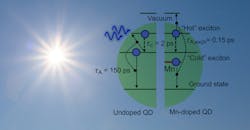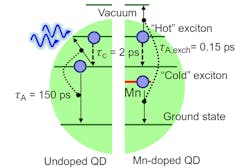Doped Quantum Dots Capture More Energy from Light Than They Lose to Heat
Los Alamos National Laboratory engineers have synthesized magnetically-doped quantum dots that capture the kinetic energy of electrons created by UV light before it’s wasted as heat. “This discovery could make it possible to make more efficient solar cells, light detectors, photocathodes, and light-driven chemical reactions,” according to Victor Klimov, lead researcher on the lab’s quantum dot project.
In standard solar cells, a large amount of sunlight energy is wasted as heat. This is because they lack an effective way to capture the kinetic energy of “hot” electrons generated by photons in the green to UV portion of the sun’s light. These hot electrons lose energy quickly due to interactions with solar cell’s crystal lattice. Instead, the energy is converted to vibrations known as phonons. This process typically takes just a few picoseconds (trillionths of a second).
Previous efforts to capture this energy have relied on the transfer of kinetic energy from an energetic hot electron to an immobile, low-energy electron, exciting it to a current-conducting state. This effect, known as carrier multiplication, doubles the number of electrons contributing to the photocurrent which can be used for boosting the performance of solar cells. In most conventional materials, however, the energy losses to phonons outweigh the energy gains of carrier multiplication.
Doping a quantum dot with manganese (right half of graphic) speeds the capture of energy from a hot electron to 0.15 picoseconds, outpacing losses to phonons in the crystal lattice.
At Los Alamos, researchers discovered that adding magnetic ions into quantum dots greatly enhances the useful, energy-producing interactions so as they become faster than wasteful phonon scattering.
To implement this idea, the team prepared manganese-doped quantum dots based on cadmium selenide. “The photon absorbed by the cadmium selenide quantum dot creates an electron-hole pair, or an exciton,” says Klimov. “This exciton is quickly —trapped by the dopant, creating an excited state that stores energy much like a compressed spring. When the second photon is absorbed by the quantum dot, the stored energy is released and transferred to the newly created exciton promoting it to a higher-energy state. The energy release by the manganese ion is accompanied by the flip of its magnetic moment, known as spin, so the process was called spin-exchange Auger energy transfer.”
One intriguing observation of team involved the extremely short time scale of the spin-exchange Auger interactions—around one tenth of a picosecond. To their surprise, these interactions were quicker than phonon emissions, which were generally believed to be the fastest process in semiconductor materials. To prove the new effect could beat phonon-assisted cooling, Los Alamos researchers showed that properly designed magnetically doped quantum dots could extract a hot electron created by an UV photon before it loses its energy to heating the crystal lattice.
These paradigm-shifting findings open exciting opportunities for the newly discovered process in boosting the performance of solar cells or driving unusual photochemical reactions. Interesting opportunities are also envisioned in areas of high sensitivity, high-speed light detection, and new types of light-driven electron sources.


